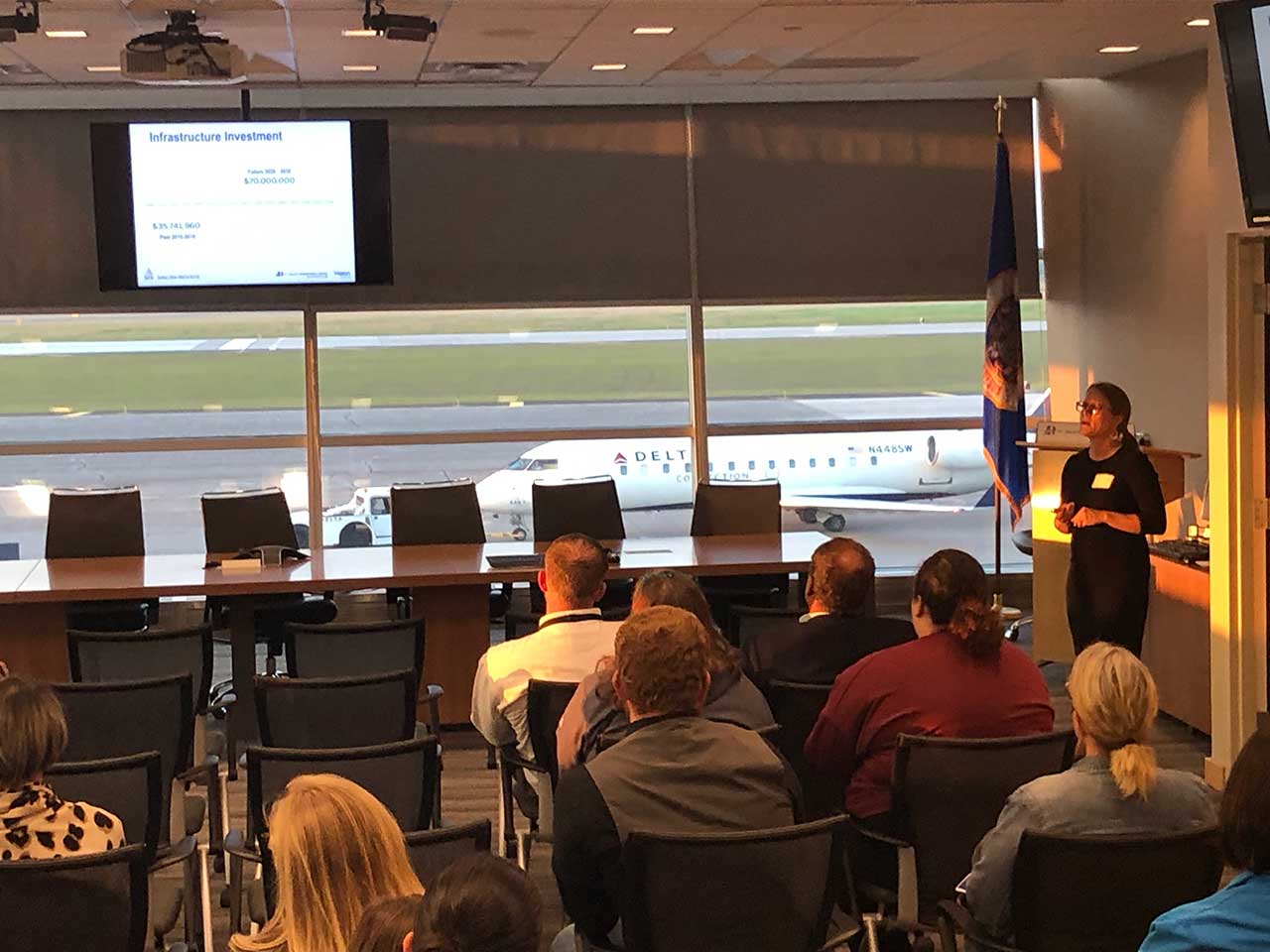Below, we highlight five ways you can educate and engage key decision makers regarding your airport project – specifically, showcasing what it takes to maintain a safe and efficient airport, the value of your airport to the community, why the funding you’re seeking is critical, and how your project will provide important growth opportunities.
You’ve met with airport tenants and the Airport Board. You’ve updated your airport Capital Improvement Program (CIP) and finished the Airport Layout Plan. You’ve had initial discussions with your state Department of Transportation (DOT) and the Federal Aviation Administration (FAA).
Your airport project is ready to go!
That is, until you attend a City Council/County Board meeting and find out local funding for your project hasn’t been approved. What can you do to secure buy-in? How can you educate decision makers on the importance of your airport, the project and funding? How can you make sure you don’t lose all of the hard work put into your project? Here are five proven tactics to consider.
1. Host an airport open house and provide a tour.
Many City Council/County Board members have never been to their local airport. Yet, their decisions specific to funding and the future of your local airport are vital.
There is a vast amount of infrastructure and pavement used to keep our facilities safe and open to the public. There are also airspace and navigational aids that need to be kept clear and in good working condition. Decision makers need to be aware of these needs at a local level so they can help with critical future processes and make informed decisions regarding the needs of their airport.
Hosting an open house and providing a detailed tour of your airport gives City Council/County Board members a chance to put their feet on the runway and drive down the taxiway – each of which are key to them feeling a sense of ownership over the proposed project. During the tour, point out the hangar owners and based aircraft that are paying fees to store aircraft at the airport, the fuel system producing revenue for operating expenses, local businesses that rely on the airport for access to the air transportation system, or the navigational aids used by pilots to access the runway.

SEH aviation staff participated in Girls in Aviation Day at the Flying Cloud Airport in Eden Prairie, Minnesota. In addition to sharing our careers in aviation, we were able to share information about ongoing Flying Cloud projects with the public.
Tours also provide an opportunity to brainstorm ways the community can use the airport to earn revenue for operating expenses. One example includes renting out conference rooms in the terminal to the public to hold community meetings or social gatherings. This brings more locals to the airport and shows them just how valuable it is to the community.
If a project isn't included in your airport CIP, it often will not be considered for federal or state funding.
– Melissa Underwood, Senior Aviation Planner
2. Hold an annual CIP meeting prior to local budget deadlines.
The FAA, and often your state DOT, require airport sponsors to provide a CIP that documents project and maintenance needs for the next 20 years at the airport. In fact, if a project isn't included in your airport CIP, it often will not be considered for federal or state funding.
The FAA and state DOTs ask that the CIP include realistic projects for at least the first three years. This helps ensure the airport sponsor has the local share of the project funding available before the DOT and FAA secure funding for a project. If the local funding share is unavailable, the project may need to be shifted to a later date. Brainstorming project needs and the local budget benefits the City Council/County Board members and gives airport staff a realistic understanding of funding availability at the local, state and federal levels.
Some communities have found it advantageous for the airport manager or a city employee to build a strong relationship and understanding of the airport with one or two County Board/City Council members. This gives city staff the opportunity to provide additional details about a project or an understanding of why a project may be recommended by the DOT or FAA.
Collaboration and communication provide decision makers with a critical understanding of project timing and funding needs before local funding requests arrive at their desks.
The Red Wing Regional Airport's 2021 CIP addresses existing needs while carefully planning for the future, meeting FAA and local DOT requirements. Here, SEH’s Tim Wegwerth and Kyle Nelson share key aspects of the program while taking viewers behind the scenes of the Airport's 6,800 sq. yd. concrete apron expansion.
3. Conduct an “Airport 101” educational session.
Education is key to success when operating a local airport. Airport managers at general aviation airports are often city administrators or public works directors who have the airport under their umbrella of responsibility. They often learn the role along the way. These individuals should share the knowledge they’re learning along the way with City Council/County Board members.
Airport 101 educational sessions are a great place to start. Sessions like these provide knowledge-sharing opportunities specific to:
- Regulations and requirements for an airport sponsor
- The types of funding available, including federal and state grants
- Your 20-year Master Plan and Airport Layout Plan
- Laying out the complex requirements that need to be met to receive state and federal funding
Beyond education, this incites collaboration. Collaboration between the airport sponsor and consultant is instrumental to keeping your airport in good standing with the state DOT and FAA – making sure you’re able to claim the funding sources available from these entities.

An SEH team leads a public involvement meeting on-site at an airport, engaging stakeholders on current projects, answering questions and sharing solutions.
4. Showcase the businesses and community members who rely on your airport.
Local airports are instrumental to local businesses/the economy and community health. Regarding community health, local airports are often used for emergency medical situations. Many medical operators use local airports for patient and donor transport. Ambulances can meet a medical helicopter or aircraft at the local airport to provide rapid transportation to/from the local hospital.
Another purpose of air travel is to reduce time spent on the road travelling to/from business meetings. The location of a local airport can attract businesses to the community, who rely on the airport for flying goods or personnel to conduct business in a timely manner. City Council/County Board members may be unaware of the local manufacturing company or retail stores that rely on your airport.
Introducing this information can provide the background needed to gain support.
Many state DOTs provide an Economic Impact Calculator – for example, WSDOT Aviation EIC, MnDOT Airport EIC, Colorado Dynamic Aviation EIC – or similar tool to share the economic benefits of aviation to the community. A local airport can provide jobs to residents, bring in goods and services to the community, and attract business outside of aviation. Consider using the Economic Impact Calculator to gain insight into the benefits and communicate them with decision makers.
Between saving lives and invigorating the local economy, decision makers need to know just how critical local airports are to the communities they reside in.
5. Host a community event at the airport.
Who doesn’t like pancakes! Many airports host a pancake breakfast and other types of communal social events to engage the community and key decision makers. For events like this, the airport sponsor often teams with local community groups to provide labor and supplies for this type of event.
These events can help community groups raise money for their organization while you continue to showcase the airport’s importance. This may make the airport a more inviting place for community members, give them an opportunity to share their love of aviation, and offer the chance for people to watch aircraft operations from a safe location.
Events like this also educate young people on the impact and opportunities within aviation. The next generation of aviation enthusiasts have an opportunity to see what the field is all about and the type of careers available to them. They can gain hands-on experience with aircraft and see what an airport looks like up close.
Conclusion: Secure your local share of critical funding.
Local airports provide essential travel and the delivery of goods and services to communities across the world. These five tactics can help to communicate just how valuable they are as you seek to move your projects forward and keep them operating safely and efficiently.
The $1 trillion infrastructure bill includes $25 billion for local airports. Have questions about the infrastructure bill, such as how the available airport funding might impact your aviation projects and how to secure these funds? Timelines? Requirements? Connect with our team of SEH aviation leaders today to get moving.
About the Authors

Melissa Underwood is an SEH senior aviation planner and project manager of more than 50 projects over the past 10 years. With 20+ years of experience, she understands that any project is possible through precise planning and forward thinking. Melissa has extensive experience in public involvement – working tirelessly to educate stakeholders on the importance of our airports and future airport developments.

Tim Wegwerth, PE* is an SEH senior airport engineer with 12+ years of industry experience in a variety of airport and municipal engineering projects. Tim’s areas of expertise include project management, grant preparation and submittal, preparation of engineering design reports, cost estimations, technical design and construction oversight
*Registered Professional Engineer in MN, WI


